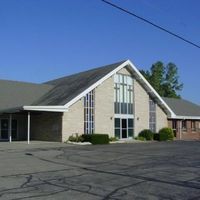We found 3 more United Methodist churches near Horton
Who we are
Hillside United Methodist Church, to the glory of God, is a community of believers who bear witness to the love and power of Jesus Christ.
Family & Community Focused
When growing a family friendly church, it is imperative to remain centered on Christ while embracing our Community.
Deeply Rooted in History and the Gospel
Methodists have a rich history in the Hanover-Horton area dating back to the first settlers in 1830's. Today, we honor and respect those traditions and continue to pursue a deeper relationship with our God in the same way as our elders before us.
Family & Community Focused
When growing a family friendly church, it is imperative to remain centered on Christ while embracing our Community.
Deeply Rooted in History and the Gospel
Methodists have a rich history in the Hanover-Horton area dating back to the first settlers in 1830's. Today, we honor and respect those traditions and continue to pursue a deeper relationship with our God in the same way as our elders before us.
Church Address

6100 Folks Road
Horton,
MI
49246
United States
Phone: (517) 563-2835
Download Hillside United Methodist Church vCard with Service Times
Click here to contact the church
Church Pastor

Rev. Crystal Thomas
Pastor
6100 Folks Road
Horton,
MI
49246
United States
Phone: (517) 563-8920
Download Pastor Rev. Crystal Thomas vCard with bio
Click here to contact Rev. Crystal Thomas
Denomination
United Methodist Church
United Methodist Churches in Horton, MI
United Methodist Churches in Michigan
United Methodist Churches in United States
United Methodist Churcheses near me
All churches in Horton, MI

Affiliations
Church Website
Hillside United Methodist Church on Social Media
Leadership
Leader Name:
Rev. Crystal Thomas
Leader Position:
Pastor
Formal Title:
Leader Address:
Phone:
Fax:
Leader Email:
Click here to contact Rev. Crystal Thomas
Leader Bio:
Rev. Crystal Thomas comes to us from the Flint, MI area.
She is a graduate of Rochester College in Rochester, MI, where she received her Bachelor’s degree in Biblical Studies. She is continuing her studies at United Theological Seminary to attain a Master of Divinity degree.
Rev. Crystal Thomas is a lifelong member of the United Methodist Church and answered her call to Ministry at a young age. As a Pastor, she tries to empower others to build a personal relationship with Jesus Christ as she uses her gifts of compassion and youthful enthusiasm to comfort, unite, and motivate everyone she meets.
She is a graduate of Rochester College in Rochester, MI, where she received her Bachelor’s degree in Biblical Studies. She is continuing her studies at United Theological Seminary to attain a Master of Divinity degree.
Rev. Crystal Thomas is a lifelong member of the United Methodist Church and answered her call to Ministry at a young age. As a Pastor, she tries to empower others to build a personal relationship with Jesus Christ as she uses her gifts of compassion and youthful enthusiasm to comfort, unite, and motivate everyone she meets.
Rev. Crystal Thomas on Social Media:
Other Church Leaders:
Leadership Photos
Add a Photo
Administration
Admin Name:
Admin Position:
Admin Address:
Phone:
Fax:
Admin Email:
Click here to contact the church
Mailing Address
Driving Directions
Travel/Direction Tips
Know how to get there? Share the knowledge with others!
Parking
Please share parking information and/or parking experience!
Hillside United Methodist Church Service Times
Worship service every Sunday at 11 AM with Sunday School for Elementary - Adult at 9:30 AM and a Fellowship hour at 10:30 AM before worship.
It's been more than a year since the last service times update. Please make sure to contact the church to confirm service times.
Please contact the church to confirm Service Times or SUBSCRIBE to updates below
It's been more than a year since the last service times update. Please make sure to contact the church to confirm service times.
Please contact the church to confirm Service Times or SUBSCRIBE to updates below
Worship Languages
Dress Code
Sunday School / Children and Youth Activities
Under 12s:
Under 18s:
Local outreach & community activities
Community Outreach:
- Food Pantry
- Reaching Out to the Community
- Back Pack Ministry
- Lunch in the Park
- Fourth of July Parade
Church Annual Events:
- Strawberry Festival
- Chicken BBQ
- Fall Festival
- Craft Show
- Harvest Dinner
- Food Pantry
- Reaching Out to the Community
- Back Pack Ministry
- Lunch in the Park
- Fourth of July Parade
Church Annual Events:
- Strawberry Festival
- Chicken BBQ
- Fall Festival
- Craft Show
- Harvest Dinner
Other activities & ministries
Music Ministry
Praise Team
Serving in Worship
Learning Opportunities
Bible Study
Book Club
Sunday School
Vacation Bible School
District Training Events
Church Organizations
United Methodist Men
United Methodist Women
Youth Group
Praise Team
Serving in Worship
Learning Opportunities
Bible Study
Book Club
Sunday School
Vacation Bible School
District Training Events
Church Organizations
United Methodist Men
United Methodist Women
Youth Group
Special Needs/Accessibility
Prayers and Hymns
Main Bible:
Hymns and Songs:
Other information
Average Adult Congregation:
Average Youth Congregation:
Additional Info:
Hillside United Methodist Church Horton Photos
Hillside United Methodist Church History
Many events altered the course of our present Hillside United Methodist Church.
The towns of Horton and Hanover were built just prior to and soon after the building of our railroads and prospered as a direct result of them. The history of both towns relates back to the Indians who had made their homes in this area along the banks of the Kalamazoo River. Some Indians managed to stay and were educated in the area, but the prosperity of the early settlers could only be achieved by joining in the American Tragedy of Dispossessing the Indians of their homeland. This was accomplished by the United States Troops in the late 1830s when over 2,000 were "rounded up" and transported further West and North. The towns could then expand considerably to include more housing and more industries such as Grist Mills, Lumbering, Hotels, etc. and ultimately to established schools and to churches built in the middle 1800s by the Methodists and the Universalists.
It's interesting to note that as these and other small towns continued to grow and retain their own identity, some did not. By comparison, Stony Point, who outshone both towns to become an almost instantaneous "boom-town" could not whether the 1890 depression and became almost an instantaneous "ghost-town".
The schools in both towns burned in the early years, disrupting the children's education only slightly because the churches and lodges of both towns supplied housing until new ones could be built. And when in 1945 the two school districts were reorganized into the Hanover-Horton School System, it led to the building of a new high school on the South West corner of Folks andMoscow roads. This was no easy task as the traditional rivalry was strong between the two adjacent towns. Fortunately, by uniting the two communities through the school system, it paved the way for the towns to negotiate when they started talking of uniting their two churches.
In the early years, churches' attendance in rural areas was relatively small, and it wasn't economically feasible for each community to support a minister. The Hanover and Horton churches fell in this group and in the 1940s, one minister served not only them but included the adjacent town of Concord. In the early 1950s however, Concord hired their own minister, and Horton and Hanover combined to form one parish. This continued until 1966 when they found it profitable to merge and build a new United Church. In 1967, the property was purchased across from the new high school on the North West corner of Folks and Moscow Roads, and the building was started the next year. The cornerstone was laid in May 1969 and the first service was held in July of the same year.
Before and during the early 1900s, a community's social life centered around the School and Church activities. This changed so rapidly in the middle 1950s and early 1960s that an extended new lifestyle emerged.
It's also relative to note that as the building of the railroads brought expansion to small towns and rural areas, so did the expansion of "across the country" building cause them to decline, and the typical small town of today was molded.
Then with the shocking disbanding of the railroads in the 1970s and new and better roads had been built to accommodate the mass of automobiles prevalent throughout the state, we were awakened to the fact that a large number of trucks, and gradually the "18 wheelers" had begun to dominate the transportation industry.
In the 1940s more and more families were finding it necessary to purchase cars and by the 1950s like the old adage "a chicken in every pot", so there was a car in every yard. By the late 1960s, there were 2 cars in every yard, and the 1970s found a pickup had been added to accommodate the "Baby Boomers" born in the 1950s who found a much more affluent world out there.
The auto industry made Michigan and it also nearly broke it. It was phenomenal in dominating the economic growth of the whole state. The Automakers and related industries made Michigan one of the most progressive states in the Union. But this reached its peak in the middle 1970s when management began to complain of high taxes, high wages and benefits, high insurance rates, and government and union intervention. in the late 1970s, they began to close up the majority of the big factories and moved them to Southern and Western states or they diversified into smaller plants.
With the advent of the automobile and the giant plants to build them, the cities provided employment and prosperity to the small towns and rural communities of which we are prime examples. Subsequently, the move from the cities to other states could have had a disastrous effect on suburbs, small towns, and rural areas had not their ingenuity and dedication to survival been so strong.
Cities have had to deal with the constant serge of inter-city residents moving into small communities and suburbs but by the same token, these areas have had to cope with these "newcomers" breaking into their close-knit social structure. This has happened to our area with the influx of the "lake-people" and the farm owners selling prime land to meet the demand for residential lots. The decrease of the small family farm into conglomerates of agricultural enterprises has also added to the charges that we must continue to face. They have joined the new 24 hours, 7 day work week of the factory worker, department store employee, and other service-oriented industries.
A continuous flow of Arts and Crafts, Specialty Shops, Electronic, and Hi-Tech industries, and many other small businesses have begun to emerge and to build back the employment and economic status again. Now it's these same small towns and rural areas that help sustain our cities to a great extent.
The churches of today do have a definite challenge in dealing with a multitude of not only local, but national and international situations and the Hillside Church has not neglected this calling. The Hillside Church School has taken on another dimension by gallantly meeting some of these head-ons, especially besetting our youth, such as the age-old problem of alcohol, the increasing problem of drugs, "latch-key kids", the drastic rise of children of divorced parents, child care, and world hunger.
The reason our church and the community that supports it have been survivors in the past and present is their constant faith in God and themselves. And so it will be in the future as they look forward to the 21st century.
- Myrt Cockran
The towns of Horton and Hanover were built just prior to and soon after the building of our railroads and prospered as a direct result of them. The history of both towns relates back to the Indians who had made their homes in this area along the banks of the Kalamazoo River. Some Indians managed to stay and were educated in the area, but the prosperity of the early settlers could only be achieved by joining in the American Tragedy of Dispossessing the Indians of their homeland. This was accomplished by the United States Troops in the late 1830s when over 2,000 were "rounded up" and transported further West and North. The towns could then expand considerably to include more housing and more industries such as Grist Mills, Lumbering, Hotels, etc. and ultimately to established schools and to churches built in the middle 1800s by the Methodists and the Universalists.
The schools in both towns burned in the early years, disrupting the children's education only slightly because the churches and lodges of both towns supplied housing until new ones could be built. And when in 1945 the two school districts were reorganized into the Hanover-Horton School System, it led to the building of a new high school on the South West corner of Folks andMoscow roads. This was no easy task as the traditional rivalry was strong between the two adjacent towns. Fortunately, by uniting the two communities through the school system, it paved the way for the towns to negotiate when they started talking of uniting their two churches.
In the early years, churches' attendance in rural areas was relatively small, and it wasn't economically feasible for each community to support a minister. The Hanover and Horton churches fell in this group and in the 1940s, one minister served not only them but included the adjacent town of Concord. In the early 1950s however, Concord hired their own minister, and Horton and Hanover combined to form one parish. This continued until 1966 when they found it profitable to merge and build a new United Church. In 1967, the property was purchased across from the new high school on the North West corner of Folks and Moscow Roads, and the building was started the next year. The cornerstone was laid in May 1969 and the first service was held in July of the same year.
It's also relative to note that as the building of the railroads brought expansion to small towns and rural areas, so did the expansion of "across the country" building cause them to decline, and the typical small town of today was molded.
Then with the shocking disbanding of the railroads in the 1970s and new and better roads had been built to accommodate the mass of automobiles prevalent throughout the state, we were awakened to the fact that a large number of trucks, and gradually the "18 wheelers" had begun to dominate the transportation industry.
In the 1940s more and more families were finding it necessary to purchase cars and by the 1950s like the old adage "a chicken in every pot", so there was a car in every yard. By the late 1960s, there were 2 cars in every yard, and the 1970s found a pickup had been added to accommodate the "Baby Boomers" born in the 1950s who found a much more affluent world out there.
With the advent of the automobile and the giant plants to build them, the cities provided employment and prosperity to the small towns and rural communities of which we are prime examples. Subsequently, the move from the cities to other states could have had a disastrous effect on suburbs, small towns, and rural areas had not their ingenuity and dedication to survival been so strong.
Cities have had to deal with the constant serge of inter-city residents moving into small communities and suburbs but by the same token, these areas have had to cope with these "newcomers" breaking into their close-knit social structure. This has happened to our area with the influx of the "lake-people" and the farm owners selling prime land to meet the demand for residential lots. The decrease of the small family farm into conglomerates of agricultural enterprises has also added to the charges that we must continue to face. They have joined the new 24 hours, 7 day work week of the factory worker, department store employee, and other service-oriented industries.
The churches of today do have a definite challenge in dealing with a multitude of not only local, but national and international situations and the Hillside Church has not neglected this calling. The Hillside Church School has taken on another dimension by gallantly meeting some of these head-ons, especially besetting our youth, such as the age-old problem of alcohol, the increasing problem of drugs, "latch-key kids", the drastic rise of children of divorced parents, child care, and world hunger.
The reason our church and the community that supports it have been survivors in the past and present is their constant faith in God and themselves. And so it will be in the future as they look forward to the 21st century.
- Myrt Cockran
Hillside United Methodist Church Historical Photos
 Give us vision
Give us vision
Give to us clear vision that we may know where to stand and what to stand for -- because unless we stand for something, we shall fall for anything.
Hillside United Methodist Church listing was last updated on the 2nd of November, 2023
THANK YOU FOR VISITING HILLSIDE UNITED METHODIST CHURCH ONLINE!
Hillside United Methodist Church Accelerated Mobile Page (AMP)














